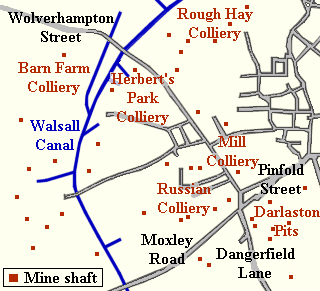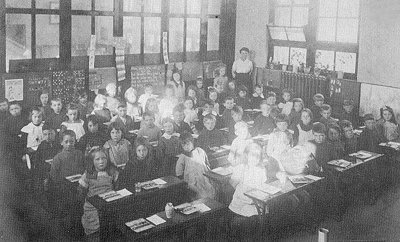| The school sits in the heart of the town’s old
mining district, on the site of the Russian Colliery.
The whole area was full of clay pits, sand pits and
many, many coal mines. The larger ones included
Darlaston Pits on the south side of Pinfold Street, Mill
Colliery where today’s Woods Bank housing estate stands,
Herbert’s Park Colliery on the site of George Rose Park,
and Lodge Hole Colliery at Kings Hill. There were also
small pits in Moxley Road, Victory Avenue and
Dangerfield Lane. |
|

Some of the many coalmines in the
area. |
By the late 19th century most of the
mineral working had ended except for a few small gin
pits and the clay pits around Moxley. At this time
Darlaston had become industrialised with large factories
dominating much of the landscape.
Because of the unstable nature of the land in most of
the old mining district, it had been ignored by 19th
century developers and had become a wasteland full of
derelict pits and old spoil heaps, such as the ones at
Herbert’s Park, and where Victory Avenue stands today.
This example became known as the “Black Bonk” (Black
Bank). |
| The town’s population continued to rapidly grow
throughout the 19th century, which resulted
in a shortage of suitable housing. Part of the area was
redeveloped in the 1860s and 1870s when houses were
built along Catherine’s Cross, Factory Street, Park
Street, Mill Street, Foundry Street, and Moxley Road. By
the 1920s much of the Victorian housing was overcrowded,
with two or more families occupying a house with a
maximum of two bedrooms. The population still continued
to increase and and something had to be done. The
solution came in the form of council houses, which were
built in large numbers. The first ones appeared in
Partridge Avenue and others soon followed in Wiley
Avenue, Berry Avenue, Stanbury
Avenue, Heathfield Lane West and Herbert’s Park Road.
Most of the local population worked in the town’s many
factories, and by the 1930s there was a need for
up-to-date, high quality primary schooling for their
children. Until the mid 1930s the area had been served
by two primary schools, Old Church School, and Dorsett
Road Council School, which became the predecessor to
Pinfold Street Primary School, and only had a relatively
short life.
|
| Dorset Road School was a revolutionary building, the
first of its kind, which became known as the
"Staffordshire Type" of school. Traditional Victorian
schools were often overcrowded and poorly ventilated,
leading to an unhealthy environment. Illnesses such as
coughs and colds would quickly spread, resulting in poor
attendances. The "Staffordshire Type" of school was well
ventilated and quickly overcame the problem. |

A class at Dorsett Road School in
1920. |
There were fewer coughs and colds and no
classroom smells, so everyone felt fresher at the end of
the day. The new type of school was designed by Dr.
Reid, the County Medical Officer, and the architects,
who collaborated to produce a healthier environment for
the children. They had clearly come up with the right
solution because many such schools were built throughout
the country. Darlaston still has one school of this
type, Salisbury Street JMI.
Dorsett Road School opened in February 1907 and had
accommodation for 1,140 pupils, by far the largest
school in the town, twice as big as any other. In the
early 1940s the school closed and the empty buildings
were purchased by Longmore's who demolished them to make
way for an extension to their factory. All that remains
of the school today is the garden wall in Dorsett Road
Terrace, which divides the newly built Woods Bank estate
from the end house in the Terrace.
In September 1936 a large number of the school's
pupils were moved to a newly built primary school,
nearby in Pinfold Street Extension. This marked the
opening of Pinfold Street Junior School. |
 |
|
 |
Return to the
beginning |
|
Proceed to
A New School |
|